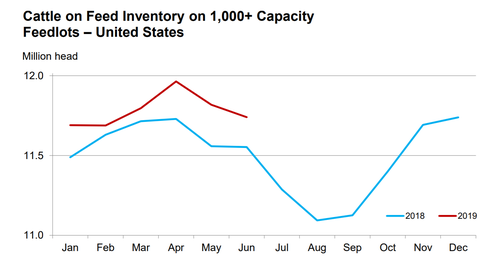Placements come in slightly lower than what trade expected.
June 24, 2019

Cattle on feed in feedlots with a capacity of 1,000 head or more totaled 11.7 million head on June 1, 2019, a 2% increase from June 1, 2018, the U.S. Department of Agriculture’s latest “Cattle on Feed” report showed. USDA said it is the highest June 1 inventory since the series began in 1996. The average pre-report trade estimate was for a 1% increase in the inventory.

Placements in feedlots during May totaled 2.06 million head, 3% below 2018 and slightly lower than pre-report estimates of 4%.
USDA livestock analyst Seanicaa Herron said the decline wasn’t really a surprise, given a few key factors: the rising cost for corn, higher hay prices and the availability of pasture, which has been “very, very good” over the last two months.
USDA has reported that 71% of pasture and rangeland are in good/excellent condition.
“We’re likely seeing more animals being held on pasture before heading to the feedlots," Herron said.
This may limit the increase in beef production this year and next, USDA relayed.
According to the report, net placements were 1.99 million head. During May, placements were 370,000 head for cattle and calves weighing less than 600 lb., 305,000 head for those weighing 600-699 lb., 500,000 head for those weighing 700-799 lb., 539,000 head for those weighing 800-899 lb., 235,000 head for those weighing 900-999 lb. and 115,000 head for those weighing 1,000 lb. and greater.
Marketings of fed cattle during May totaled 2.07 million head, 1% above 2018 and in line with pre-report estimates.
Other disappearance totaled 72,000 head during May, 1% below May 2018.
You May Also Like



